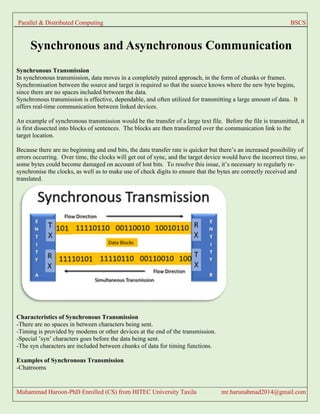
Lecture 03 - Synchronous and Asynchronous Communication - Concurrency - Fault Tolerance
- 1. Parallel & Distributed Computing BSCS Muhammad Haroon-PhD Enrolled (CS) from HITEC University Taxila mr.harunahmad2014@gmail.com Synchronous and Asynchronous Communication Synchronous Transmission In synchronous transmission, data moves in a completely paired approach, in the form of chunks or frames. Synchronisation between the source and target is required so that the source knows where the new byte begins, since there are no spaces included between the data. Synchronous transmission is effective, dependable, and often utilized for transmitting a large amount of data. It offers real-time communication between linked devices. An example of synchronous transmission would be the transfer of a large text file. Before the file is transmitted, it is first dissected into blocks of sentences. The blocks are then transferred over the communication link to the target location. Because there are no beginning and end bits, the data transfer rate is quicker but there’s an increased possibility of errors occurring. Over time, the clocks will get out of sync, and the target device would have the incorrect time, so some bytes could become damaged on account of lost bits. To resolve this issue, it’s necessary to regularly re- synchronise the clocks, as well as to make use of check digits to ensure that the bytes are correctly received and translated. Characteristics of Synchronous Transmission -There are no spaces in between characters being sent. -Timing is provided by modems or other devices at the end of the transmission. -Special ’syn’ characters goes before the data being sent. -The syn characters are included between chunks of data for timing functions. Examples of Synchronous Transmission -Chatrooms
- 2. Parallel & Distributed Computing BSCS Muhammad Haroon-PhD Enrolled (CS) from HITEC University Taxila mr.harunahmad2014@gmail.com -Video conferencing -Telephonic conversations -Face-to-face interactions Asynchronous Transmission In asynchronous transmission, data moves in a half-paired approach, 1 byte or 1 character at a time. It sends the data in a constant current of bytes. The size of a character transmitted is 8 bits, with a parity bit added both at the beginning and at the end, making it a total of 10 bits. It doesn’t need a clock for integration—rather, it utilizes the parity bits to tell the receiver how to translate the data. It is straightforward, quick, cost-effective, and doesn’t need 2-way communication to function. Characteristics of Asynchronous Transmission -Each character is headed by a beginning bit and concluded with one or more end bits. -There may be gaps or spaces in between characters. Examples of Asynchronous Transmission -Emails -Forums -Letters -Radios -Televisions
- 3. Parallel & Distributed Computing BSCS Muhammad Haroon-PhD Enrolled (CS) from HITEC University Taxila mr.harunahmad2014@gmail.com Synchronous and Asynchronous Transmission Point of Comparison Synchronous Transmission Asynchronous Transmission Definition Transmits data in the form of chunks or frames Transmits 1 byte or character at a time Speed of Transmission Quick Slow Cost Expensive Cost-effective Time Interval Constant Random Gaps between the data? Yes No Concurrency -A situation in which two or more persons access the same record simultaneously is called Concurrency. -Concurrency control is a database management systems (DBMS) concept that is used to address occur with a multi- user system. Concurrency control, when applied to a DBMS, is meant to coordinate simultaneous transactions while preserving data integrity. -Concurrency control involves the synchronization of accesses to the distributed database , such that the integrity of the database is maintained. -The concurrency control problem in a distributed context is somewhat different than in a centralized framework. -One not only has to worry about the integrity of a single database, but also about the consistency of multiple copies of the database. -The condition that requires all the values of multiple copies of every data item to converge to the same value is called Mutual consistency. Fault Tolerance Fault tolerance mechanism can be divided into three stages; Hardware, Software, and System Fault Hardware Fault Tolerance: This involves the provision of supplementary backup hardware such as; CPU, Memory, Hard disks, Power Supply Units, etc. hardware fault tolerance can only deliver support for the hardware by providing the basic hardware backup system, it can’t stop or detect error, accidental interfering with programs, program errors, etc. In hardware fault tolerance, computer systems that resolves fault occurring from hardware component automatically are built. Software Fault Tolerance: This is a special software designed to tolerate errors that would originate from a software or programming errors. The software fault tolerance utilize the static and dynamic redundancy methods similar to those used for hardware fault.
- 4. Parallel & Distributed Computing BSCS Muhammad Haroon-PhD Enrolled (CS) from HITEC University Taxila mr.harunahmad2014@gmail.com System Fault Tolerance: This is a complete system that stores not just checkpoints, it detects error in application, it stores memory block, program checkpoint automatically. When a fault or an error occurs, the system provides a correcting mechanism thereby correcting the error.
- 5. Parallel & Distributed Computing BSCS Muhammad Haroon-PhD Enrolled (CS) from HITEC University Taxila mr.harunahmad2014@gmail.com
- 6. Parallel & Distributed Computing BSCS Muhammad Haroon-PhD Enrolled (CS) from HITEC University Taxila mr.harunahmad2014@gmail.com
